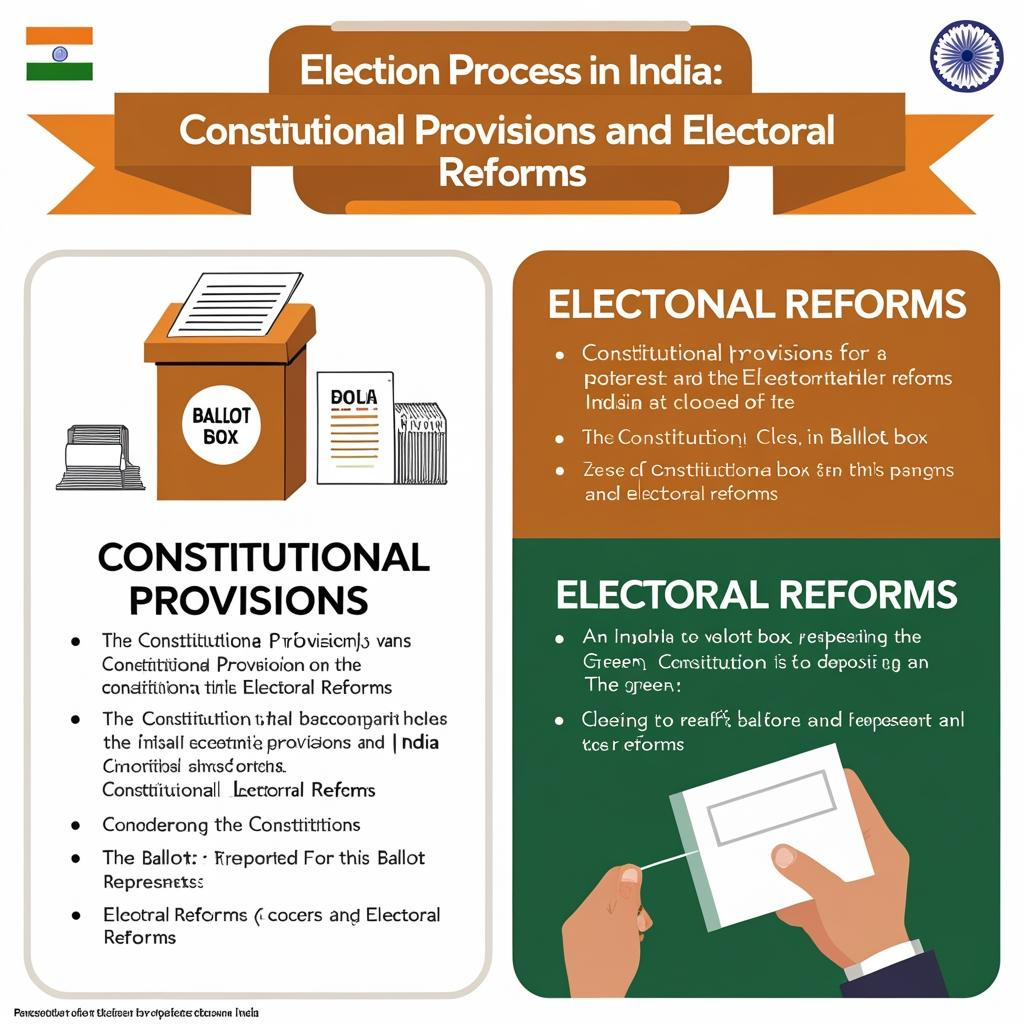1. Introduction
Elections are the lifeblood of democracy. In India, they determine the composition of the Parliament, State Legislatures, and local bodies, enabling citizens to choose their representatives and hold them accountable.
The Constitution of India lays down detailed provisions for the conduct of free and fair elections, entrusting the Election Commission of India (ECI) with the responsibility of managing them.
For UPSC aspirants, the topic is significant for GS Paper II, with overlaps in Prelims (Articles, institutions) and Essay on democracy, governance, and electoral reforms.
Also Visit – Best IAS Coaching in India
2. Historical Background
- British Period: Indian Councils Act, 1909 (Morley–Minto Reforms) introduced limited representation.
- Government of India Act, 1919: Extended franchise to a larger number of Indians.
- Government of India Act, 1935: Laid down the framework for provincial elections.
- Post-Independence: The first general elections in 1951–52 were conducted under the new constitutional framework, becoming the world’s largest democratic exercise.
3. Constitutional Provisions on Elections
3.1 Relevant Articles
- Article 324: Vests the superintendence, direction, and control of elections in the ECI.
- Articles 325–329: General provisions relating to elections, disqualification, and bar on judicial interference in electoral matters before completion.
- Articles 330–342: Provisions for reservation of seats for SC/STs and representation of Anglo-Indians (now abolished).
- Article 326: Universal adult suffrage — every citizen above 18 years has the right to vote.
3.2 Schedules
- Schedule 1: Number of seats for each state in Parliament.
- Schedule 3: Oath and affirmation by candidates and elected members.
3.3 Related Laws
- Representation of the People Act, 1950 (delimitation, allocation of seats).
- Representation of the People Act, 1951 (conduct of elections, qualifications, disqualifications).
4. Election Commission of India (ECI)
Structure
- A three-member body: Chief Election Commissioner (CEC) + two Election Commissioners.
- Appointed by the President; service conditions similar to Supreme Court judges.

Functions
- Preparation of electoral rolls.
- Delimitation of constituencies.
- Allotment of symbols to political parties.
- Conduct of elections to Parliament, State Legislatures, President, and Vice-President.
- Model Code of Conduct enforcement.
5. Election Process in India
5.1 Step 1: Delimitation
- Division of the country into constituencies based on population (handled by Delimitation Commission).
5.2 Step 2: Preparation of Electoral Rolls
- Updated periodically; citizens above 18 years can enroll as voters.
5.3 Step 3: Notification
- Election dates announced by the ECI.
5.4 Step 4: Nomination of Candidates
- Candidates file nomination papers; scrutiny by returning officers.
5.5 Step 5: Election Campaign
- Political parties and candidates present their agendas.
- Model Code of Conduct comes into force.
5.6 Step 6: Polling
- Electronic Voting Machines (EVMs) and Voter Verified Paper Audit Trail (VVPAT) used.
5.7 Step 7: Counting of Votes
- Conducted under ECI supervision; results declared.
5.8 Step 8: Formation of Government
- Majority party or coalition invited to form government.
6. Types of Elections
- General Elections: For Parliament and State Assemblies every 5 years.
- By-Elections: To fill vacancies.
- Presidential & Vice-Presidential Elections.
- Elections to Rajya Sabha & Legislative Councils (indirect).
- Local Body Elections (Panchayats, Municipalities).
7. Electoral Reforms in India
7.1 Pre-2000 Reforms
- Lowering of Voting Age: From 21 to 18 years (61st Amendment, 1988).
- Anti-Defection Law: Tenth Schedule, 1985.
- Electronic Voting Machines (EVMs): Introduced in 1998.
7.2 Post-2000 Reforms
- Disclosure of Criminal Records: Supreme Court (2002) mandated candidates to declare assets, liabilities, and criminal cases.
- NOTA Option: Introduced in 2013.
- Ceiling on Election Expenditure: Set limits for candidates.
- VVPAT: Added for transparency.
7.3 Ongoing and Proposed Reforms
- State Funding of Elections: To curb money power.
- Simultaneous Elections: To reduce cost and disruption.
- Decriminalisation of Politics: Disqualifying candidates with serious criminal charges.
- Strengthening ECI Independence: Collegium system for appointments.
8. Issues in Indian Elections
- Money Power: Use of unaccounted funds in campaigning.
- Criminalisation of Politics: Many elected representatives face criminal charges.
- Misuse of Government Machinery: For electoral gains.
- Vote Buying & Booth Capturing: Though reduced with EVMs, still a concern.
- Low Voter Turnout: Urban apathy and logistical challenges in remote areas.
- Election Violence: Sporadic incidents affecting free conduct.

9. Landmark Judicial Interventions
- Indira Nehru Gandhi v. Raj Narain (1975): Struck down 39th Amendment; emphasised free and fair elections as part of the basic structure.
- PUCL v. Union of India (2003): Right to know candidate’s background is part of Article 19(1)(a).
- Lily Thomas v. Union of India (2013): Disqualified convicted legislators immediately.
10. Role of Technology in Elections
- EVMs and VVPATs ensure accuracy and reduce fraud.
- cVIGIL App: Citizens can report Model Code of Conduct violations.
- Online voter registration and electoral roll search.
- Use of data analytics for better deployment of resources.
11. UPSC Relevance
Prelims Focus:
- Articles 324–329, 326.
- Representation of the People Acts.
- Structure and powers of ECI.
Mains Angle:
- GS Paper II: “Discuss the significance of electoral reforms for strengthening Indian democracy.”
- Essay Topics: “Free and fair elections: the foundation of a democratic polity.”
12. Conclusion
The Indian electoral system is a massive democratic machinery, unparalleled in scale and diversity. While it has enabled peaceful transfers of power for over seven decades, challenges like money power, criminalisation, and declining voter engagement persist.
Strengthening the Election Commission, implementing deep reforms, and fostering an informed electorate are essential to keep the electoral process transparent, inclusive, and truly representative.
For Answer Writing Techniques – Join FIRST IAS INSTITUTE

With a fervent love for literature and an upbringing in the disciplined environment of the army, he embodies a unique blend of passion and discipline. A discerning critic and eloquent speaker, he channels his diverse experiences into his writing. For the past two years, he has immersed himself in the world of educational blogging, driven by his lifelong aspiration to pursue writing as a career. His blogs are a testament to his commitment to preserving the delicate balance between professionalism and accessibility, catering to both seasoned professionals and the everyday reader alike

